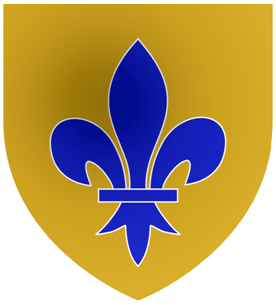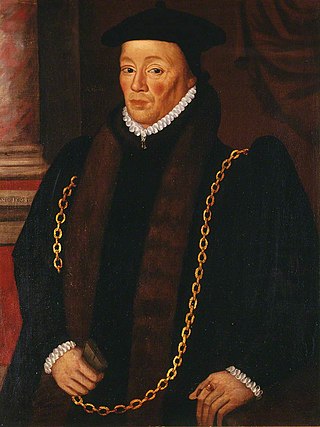
Bethlem Royal Hospital, also known as St Mary Bethlehem, Bethlehem Hospital and Bedlam, is a psychiatric hospital in Bromley, London. Its famous history has inspired several horror books, films, and TV series, most notably Bedlam, a 1946 film with Boris Karloff.

Bridewell Palace in London was built as a residence of King Henry VIII and was one of his homes early in his reign for eight years. Given to the City of London Corporation by his son King Edward VI in 1553 as Bridewell Hospital for use as an orphanage and place of correction for wayward women, Bridewell later became the first prison/poorhouse to have an appointed doctor.
The Comptroller of the Household is an ancient position in the British royal household, nominally the second-ranking member of the Lord Steward's department after the Treasurer of the Household. The Comptroller was an ex officio member of the Board of Green Cloth, until that body was abolished in the reform of local government licensing in 2004. In recent times, a senior government whip has invariably occupied the office. On state occasions the Comptroller carries a white staff of office, as often seen in portraits.

King Edward's Witley is a private co-educational boarding and day school, founded in 1553 by King Edward VI and Nicholas Ridley, Bishop of London and Westminster, in The Palace of Bridewell near Fleet St in the City of London. The School is located in the village of Wormley, Surrey, England, having moved to its present location in 1867. The School became fully co-educational in 1952. As of September 2010, the school has joined the small number of independent schools in the UK which offer the IB Diploma Programme in place of A-Levels in the sixth form. The school re-introduced A-levels as part of the curriculum from September 2015.
The Master Mercers of the Worshipful Company of Mercers have been, by reign:

The Sheriff is the oldest secular office under the Crown. Formerly the Sheriff was the principal law enforcement officer in the county but over the centuries most of the responsibilities associated with the post have been transferred elsewhere or are now defunct, so that its functions are now largely ceremonial.

The Monro of Fyrish family were a Scottish family and branch of the ancient highland Clan Munro. The family produced a notable dynasty of doctors to London in the 18th and 19th century where they were involved in early work on curing 'insanity'. Four generations occupied successively the position of (Principal) Physician of the notorious Bethlem Hospital (Bedlam). They were also leading members of a variety of important medical associations. Other members were painters, priests and philanthropists of note and one was an important early patron to J. M. W. Turner.
This is a list of Sheriffs of Caernarvonshire.

Sir Rowland Hill of Soulton, was the publisher of the Geneva Bible, thereby earning the title "The First Protestant Lord Mayor of London", having held that office in 1549. He was a statesman, polymath, merchant and patron of art and philanthropist active through the reigns of Henry VIII, Edward VI, Mary I and Elizabeth I. He is associated with the recovery and development of Tudor English drama a generation before Shakespeare, and events that Hill was involved in may have shaped one or more Shakespearean characters.

Sir Robert Geffrye (1613–1703) was an English merchant, slave trader, and Lord Mayor of London for 1685/86.

Sir William Portman was an English judge, politician and Chief Justice of the King's Bench. He was MP for Taunton in 1529 and 1536, and an associate of Thomas Cromwell.
This is a list of High Sheriffs of Carmarthenshire. Carmarthenshire was originally created by the Statute of Rhuddlan in 1284. It became an administrative county in 1889 with a county council following the Local Government Act 1888. Under the Local Government Act 1972, the administrative county of Carmarthenshire was abolished on 1 April 1974 and the area of Carmarthenshire became three districts within the new county of Dyfed : Carmarthen, Dinefwr and Llanelli. Under the Local Government (Wales) Act 1994, Dyfed was abolished on 1 April 1996 and the three districts united to form a unitary authority which had the same boundaries as the original Carmarthenshire but remaining in the shrievalty of Dyfed.

Sir James Sanderson, 1st Baronet was an English banker, a Member of Parliament, an alderman and Lord Mayor of London. He also served as president of Bridewell Hospital, and was a member of William Wilberforce's Proclamation Society for the Discouragement of Vice.

Sir William Garrard (1507–1571), also Garrett, Gerrarde, etc., was a Tudor magnate of London, a merchant citizen in the Worshipful Company of Haberdashers, who became alderman, Sheriff (1552–1553) and Lord Mayor of London (1555–1556) and was returned as an MP for the City of London. He was a senior founding officer of the Company of Merchant Adventurers to New Lands in 1554/55, having been involved in its enterprises since the beginnings in King Edward VI's time, and for the last decade of his life was one of its permanent governors. He worked hard and invested largely to expand English overseas trade not only to Russia and the Levant but also to the Barbary Coast and to West Africa and Guinea.

Sir Martin Bowes was a very prominent and active civic dignitary of Tudor London whose career continued through the reigns of Henry VIII, Edward VI, Mary I and Elizabeth I. Born into the citizenry of York, Bowes was apprenticed in London and made his career at the Royal Mint, as a master-worker and under-treasurer, and personally implemented the debasement of English currency which became a fiscal imperative in the later reign of Henry.

Sir Thomas Bennett or Bennet (1543–1627) was an English merchant and Lord Mayor of London in 1603–04.

Sir Rowland Hayward was a London slave merchant, and Lord Mayor of the City in both 1570 and 1591. Through his commercial activities he acquired considerable wealth, and was able to loan money to Queen Elizabeth I and purchase properties in several counties as well as houses in and near London. He entertained the Queen at King's Place in 1587.
Sir William Chester was one of the leading English Merchants of the Staple and Merchant Adventurers of the mid-16th century, five times Master of the Worshipful Company of Drapers, Lord Mayor of London in the year 1560–61 and Member of Parliament for the City of London. He should not be confused with his contemporary, William Chester, merchant of Bristol, M.P.

Sir William Charles Hood was a British medical doctor and psychiatrist of the Victorian era who pioneered the humane treatment of the mentally ill. As Superintendent at Bethlem Royal Hospital in London he reformed and civilised the hospital's regime.
















